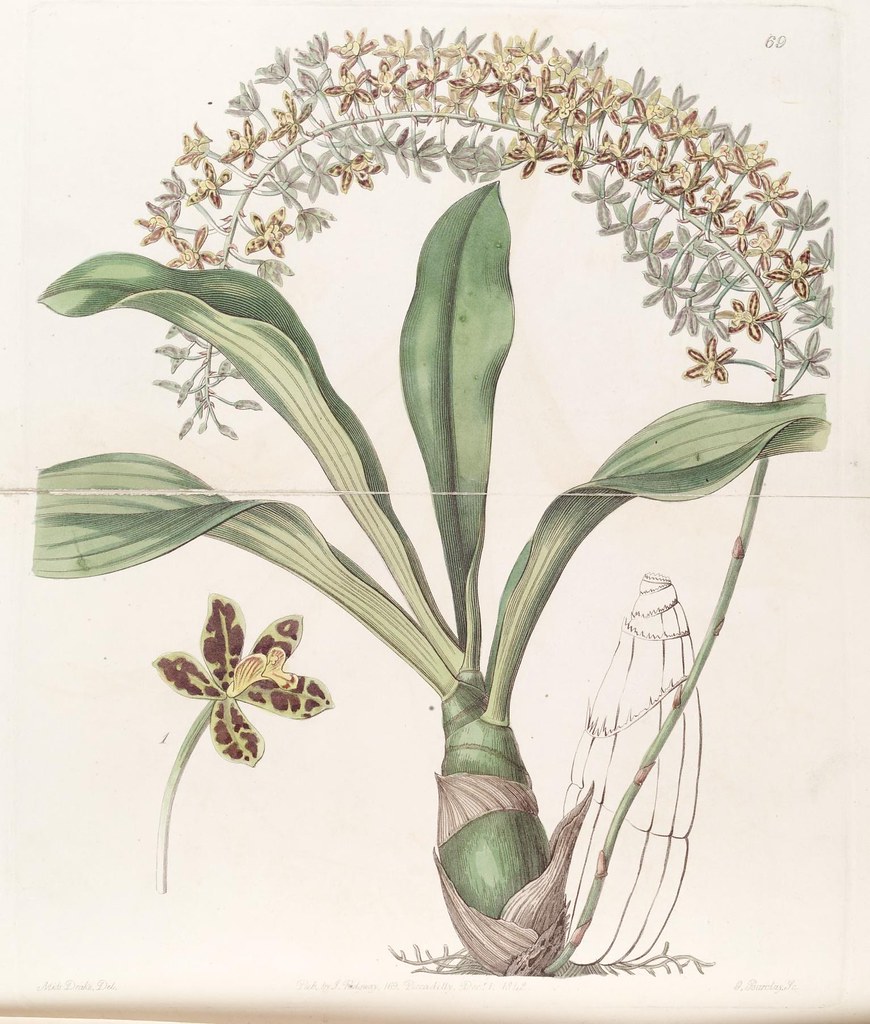#19th century philippines
Text


[ocs] draped in your warmth
#illustration#sapphic art#wlw art#sapphic#19th century philippines#roska draws#i can't wait to draw them more!! (proceeds to draw other characters)#roska's OCs#wowee new tag alert
153 notes
·
View notes
Photo




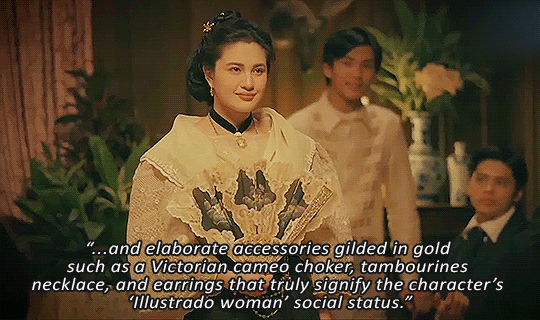
Costumes in Maria Clara at Ibarra Pt. 1
Notes and details about the historical costumes from the show according to the stylists. Interview here: (x)
Part 2 of the gifset
Additional notes:
Ilustrado is a term for the educated class of Filipinos during the Spanish Colonial period.
#maria clara at ibarra#maria clara delos santos#noli me tangere#perioddramaedit#perioddramasource#period drama costumes#period costumes#19th century#19th century philippines#period drama#perioddramacentral#weloveperioddrama#barbie forteza#julie anne san jose#mcai
678 notes
·
View notes
Text

i have been preparing my stories set to be published in fall 2024! (hopefully!)
0 notes
Text
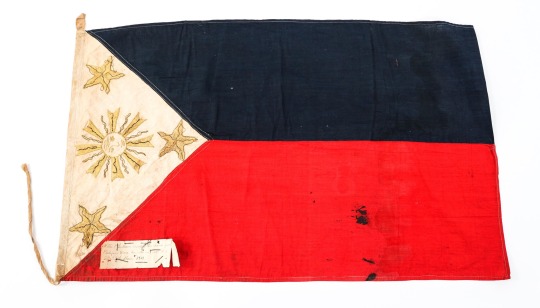

An early Philippine flag dated to the Philippine-American War. (Source)
235 notes
·
View notes
Text
19th Century Philippines Clothing (Upper Class)
Featuring William Shakespeare (Ikemen Vampire) and Auburn (@azulashengrottospiano)
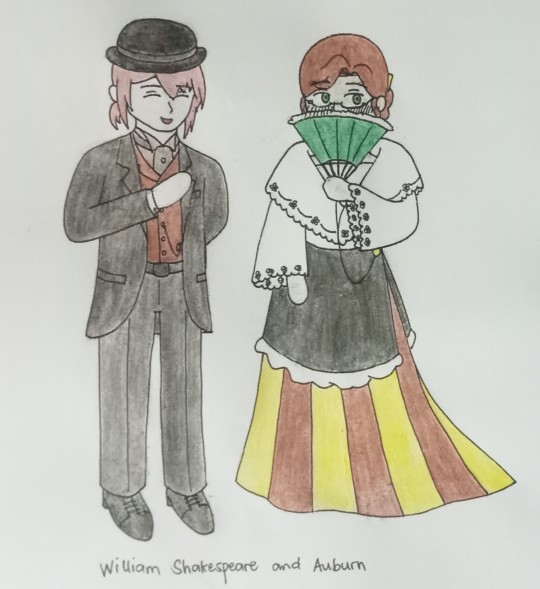
Full photo:
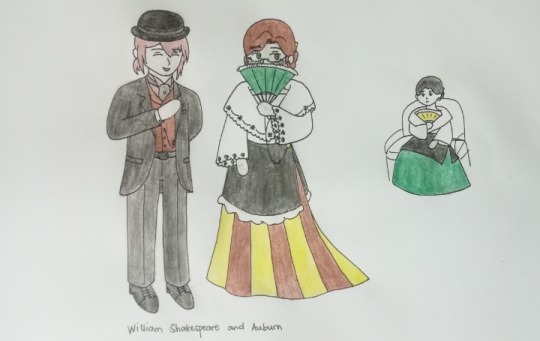
Just a guy from overseas visiting his ladylove 🤭
Fun facts:
– The traje de mestiza (translation: mestiza's gown), popularly known as the Maria Clara gown, is a type of traditional clothing in the Philippines worn by the upper-class Filipino women during the Spanish colonial era. It got it's name from Maria Clara, the heroine of the novels Noli Me Tangere and El Filibusterismo by Dr. Jose Rizal.
The camisa (blouse) and pañuelo or alampay (neckerchief) are made of piña, a type of fabric made from pineapple leaves' fibres. The saya (skirt) and the tapis (overskirt) are made of more opaque material like cotton or silk. Brocade and Jacquard fabrics are also used to make saya skirts worn by the upper-class women.
– Women at the time accessorize themselves by wearing peineta or payneta (decorative hair comb), necklaces, earrings, and abanikos (hand fans).
– Men who studied overseas (also called as Ilustrados, meaning "enlightened ones") are usually shown in photographs wearing late Victorian-style clothing. Upper-class Filipino men who lives in the Philippines during the 19th century wear barong tagalog which is also made of piña cloth. Canes are also a symbol of wealth amongst the upper class.
– Unmarried women are not allowed to meet a man alone without an older female relative watching over them. This is to ensure that the pair will not do something that is against the customs of the time (will elaborate on the next bullet).
– Unmarried couples are not allowed to hold each other, let alone kiss each other (kinda forgot but I think it has something to do with keeping a lady's purity until marriage or something).
If a man accidentally kissed an unmarried woman, he must take responsibility for it and marry her.
That's pretty much it! I had fun drawing these two— er, three, if the lady in the background is counted.
#can you even consider this an au? maybe??#cookie's art/doodles#ikemen vampire#ikevamp#ikemen vampire fanart#ikevamp fanart#ikevamp shakespeare#ikemen vampire shakespeare#19th century Philippine clothing
14 notes
·
View notes
Photo

Hymen, oh Hyménée! (1889)
by Juan Luna (1857-1899)
#juan luna#hymen oh hymenee#art#oil on canvas#late 19th century#philippine art#advanced happy independence day mga kababayan
26 notes
·
View notes
Text

Filipina Mestiza from the early 19th century. Practising digital painting lately without references.
#characterdesign#art#characterart#drawing#ocs#sketch#philippine history#philippines#history philippines#filipino history#filipina#maria clara at ibarra#noli me tangere#19th century
4 notes
·
View notes
Photo

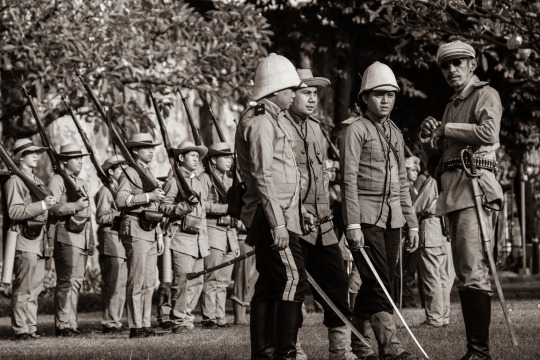


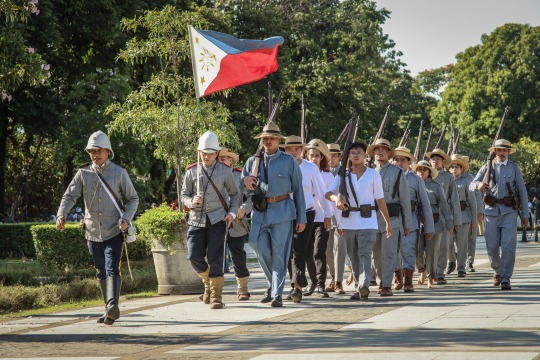
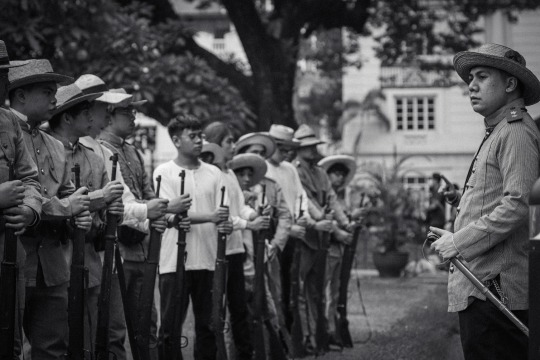
It started out in 2019 as a small bunch of guys trying to figure out 19th century Spanish military drills on a driveway in U.P. Diliman.
Now we are the largest and most active reenactment group in the Philippines, capable of accurately portraying units of the Army of the First Philippine Republic (1898-1902) and the Guardia Civil Veterana of Manila (1872-1898), and reenacting battles from the Philippine Revolution against Spain and the Philippine-American War.
Very proud to see how far the Republica Filipina Reenactment Group has come. And we still have so much more planned ahead! Abangan!
Photos taken by Mr. Albert Labrador
Update: As of Nov 2023, I and majority of the members have left RFRG and have formed a new group to continue to pursue our vision for living history in the Philippines. Follow Historia Viviente Manila on Facebook and Instagram!
#philippines#history#living history#historical reenactment#reenactment#philippine revolutionary army#guardia civil veterana#republica filipina#military history#19th century
9 notes
·
View notes
Text
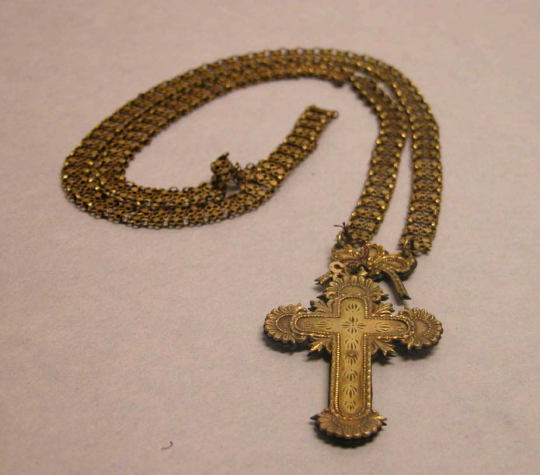

Necklace
17th–19th century
Philippines
The Metropolitan Museum of Art
#historical jewelry#17th century jewelry#18th century jewelry#19th century jewelry#filipino jewelry#jewelry#17th century#18th century#19th century#philippines#necklaces#gold
12 notes
·
View notes
Video
n202_w1150 by Biodiversity Heritage Library
Via Flickr:
Edwards's botanical register.. London :James Ridgway,1829-1847.. biodiversitylibrary.org/page/242183
#1829#19th century#Botany#Copper engraving#England#Graphic media :#Great Britain#Hand-colored#Icones#Periodicals#Pictorial works#Plants#Ornamental#Missouri Botanical Garden#Peter H. Raven Library#dc:identifier=http://biodiversitylibrary.org/page/242183#flowers#Philippines#James Ridgway#Sarah Ann Drake#illustrator:wikidata=Q7422261#Grammatophyllum multiflorum#multiflowered grammatophyllum#orchid#orchids#botanical illustration#scientific illustration
0 notes
Text
Pith helmet

A lightweight cloth-covered helmet made of sholapith. The pith helmet originates from the Spanish military adaptation of the native salakot headgear of the Philippines. It was often worn by European travellers and explorers, in varying climates found in Southeast Asia, Africa, and the tropics, but was also used in many other contexts. It was routinely issued to European military personnel serving overseas in hot climates from the mid-19th century to the mid-20th century.
1 note
·
View note
Text
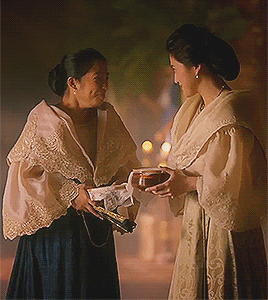
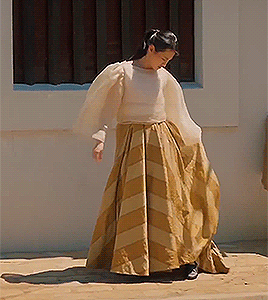



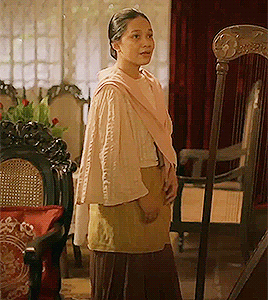


Maria Clara at Ibarra | Period Costumes
19th century Philippines
#maria clara at ibarra#maria clara delos santos#perioddramaedit#perioddramasource#period drama costumes#period costume#period drama#19th century#19th century philippines#julie anne san jose#barbie forteza#andrea torres#weloveperioddrama#perioddramacentral#so the costume designers spent a lot of time on researching costumes#to make it as accurate as possible#the clothes are made from pineapple fibers too like traditional baro't saya#i think the costumes are SO BEAUTIFUL#when more episodes come from hopefully we get longer clips of what common people wore#i'll keep doing these as the show goes#also the weapon the lady in the last gif is holding was specially crafter too!
953 notes
·
View notes
Text
In fact, far more Asian workers moved to the Americas in the 19th century to make sugar than to build the transcontinental railroad [...]. [T]housands of Chinese migrants were recruited to work [...] on Louisiana’s sugar plantations after the Civil War. [...] Recruited and reviled as "coolies," their presence in sugar production helped justify racial exclusion after the abolition of slavery.
In places where sugar cane is grown, such as Mauritius, Fiji, Hawaii, Guyana, Trinidad and Suriname, there is usually a sizable population of Asians who can trace their ancestry to India, China, Japan, Korea, the Philippines, Indonesia and elsewhere. They are descendants of sugar plantation workers, whose migration and labor embodied the limitations and contradictions of chattel slavery’s slow death in the 19th century. [...]
---
Mass consumption of sugar in industrializing Europe and North America rested on mass production of sugar by enslaved Africans in the colonies. The whip, the market, and the law institutionalized slavery across the Americas, including in the U.S. When the Haitian Revolution erupted in 1791 and Napoleon Bonaparte’s mission to reclaim Saint-Domingue, France’s most prized colony, failed, slaveholding regimes around the world grew alarmed. In response to a series of slave rebellions in its own sugar colonies, especially in Jamaica, the British Empire formally abolished slavery in the 1830s. British emancipation included a payment of £20 million to slave owners, an immense sum of money that British taxpayers made loan payments on until 2015.
Importing indentured labor from Asia emerged as a potential way to maintain the British Empire’s sugar plantation system.
In 1838 John Gladstone, father of future prime minister William E. Gladstone, arranged for the shipment of 396 South Asian workers, bound to five years of indentured labor, to his sugar estates in British Guiana. The experiment with “Gladstone coolies,” as those workers came to be known, inaugurated [...] “a new system of [...] [indentured servitude],” which would endure for nearly a century. [...]
---
Bonaparte [...] agreed to sell France's claims [...] to the U.S. [...] in 1803, in [...] the Louisiana Purchase. Plantation owners who escaped Saint-Domingue [Haiti] with their enslaved workers helped establish a booming sugar industry in southern Louisiana. On huge plantations surrounding New Orleans, home of the largest slave market in the antebellum South, sugar production took off in the first half of the 19th century. By 1853, Louisiana was producing nearly 25% of all exportable sugar in the world. [...] On the eve of the Civil War, Louisiana’s sugar industry was valued at US$200 million. More than half of that figure represented the valuation of the ownership of human beings – Black people who did the backbreaking labor [...]. By the war’s end, approximately $193 million of the sugar industry’s prewar value had vanished.
Desperate to regain power and authority after the war, Louisiana’s wealthiest planters studied and learned from their Caribbean counterparts. They, too, looked to Asian workers for their salvation, fantasizing that so-called “coolies” [...].
Thousands of Chinese workers landed in Louisiana between 1866 and 1870, recruited from the Caribbean, China and California. Bound to multiyear contracts, they symbolized Louisiana planters’ racial hope [...].
To great fanfare, Louisiana’s wealthiest planters spent thousands of dollars to recruit gangs of Chinese workers. When 140 Chinese laborers arrived on Millaudon plantation near New Orleans on July 4, 1870, at a cost of about $10,000 in recruitment fees, the New Orleans Times reported that they were “young, athletic, intelligent, sober and cleanly” and superior to “the vast majority of our African population.” [...] But [...] [w]hen they heard that other workers earned more, they demanded the same. When planters refused, they ran away. The Chinese recruits, the Planters’ Banner observed in 1871, were “fond of changing about, run away worse than [Black people], and … leave as soon as anybody offers them higher wages.”
When Congress debated excluding the Chinese from the United States in 1882, Rep. Horace F. Page of California argued that the United States could not allow the entry of “millions of cooly slaves and serfs.” That racial reasoning would justify a long series of anti-Asian laws and policies on immigration and naturalization for nearly a century.
---
All text above by: Moon-Ho Jung. "Making sugar, making 'coolies': Chinese laborers toiled alongside Black workers on 19th-century Louisiana plantations". The Conversation. 13 January 2022. [All bold emphasis and some paragraph breaks/contractions added by me.]
456 notes
·
View notes
Note
hey you might've been asked this before sorry if so, but have you read or do you have any thoughts on A short history of Trans Misogyny?
I have read it! I have a few thoughts.
I think it's a strong and important work that compiles historical archives into sharp analyses of how "trans misogyny" (using Jules Gill-Peterson's spacing) is not a recent phenomenon but a globalized structure with centuries of history. I also think it's flawed, for reasons I'll get into after a quick summary for those who haven't had the chance to read it yet.
JGP divides the book into three main chapters, the first on the notion of "trans panic". There, she traces how variants of this anxiety with the trans-feminized subject have presented—to deadly effect, for the subject—in such different settings as early colonial India, the colonization of the Americas, the racialized interactions between US soldiers stationed in the Philippines and the local trans women living there, and of course the contemporary United States itself. In every case she analyzes this "panic" as the reaction of the capitalist colonial enterprise to the conceptual threat that the trans-feminized subject poses; we are a destabilizing entity, a gender glitch that undermines the rigid guarantees of the patriarchal order maintaining capitalism. Punishment follows.
The second chapter is my favourite, and considers the relationship between transfeminine life and sex work. I posted a concluding excerpt but the thrust of the chapter is this: that the relegation of so many trans women and trans-feminized people to sex work, while accompanied by the derogation and degradation that is associated with sex work, is not itself the mere result of that degradation inflicted upon the subject. In other words, it is not out of pure helplessness and abjection that so many trans-feminized people are involved in sex work. Rather, sex work is a deliberate and calculated choice made by many trans-feminized people in increasingly service-based economies that present limited, often peripheralized, feminized, and/or reproductive, options for paid labour. Paired with a pretty bit of critical confabulation about the histories of Black trans-feminized people travelling the US in the 19th century, I think this made for great reading.
In her third chapter, JGP narrativizes the 20th century relationship between the "gay" and "trans" movements in north america—scare quoted precisely because the two went hand-in-hand for much of their history. She emphasizes this connection, not merely an embedding of one community within another but the tangled mutualism of experiences and subjectivities that co-constituted one another, though not without tension. Then came the liberal capture of the gay rights movement around the 70s, which brought about the famous clashes between the radicalisms of Silvia Rivera and Marsha P Johnson (neither of whom, JGP notes, ever described themselves as trans women) and the institutions of gay liberalism that desired subsumption into the folds of capital. This is a "remember your history" type of chapter, and well-put.
I think JGP is correct to insist, in her introduction, on the globalizing-in-a-destructive-sense effects of the colonial export of trans womanhood. It is, after all, an identity conceived only mid-century to make sense of the medicalized trans subject; and "gender identity" itself (as JGP describes in Histories of the Transgender Child) is a psychomedical concept conceived to rein in the epistemic instability of trans existence. This is critical to keep in mind! But I also think JGP makes a few mistakes, and one of them has to do with this point.
In her first chapter, under the discussion of trans misogyny in colonial India, JGP of course uses the example of the hijra. Unfortunately, she commits two fundamental errors in her use: she mythologizes, however ambiguously, the "ascetic" lives of hijra prior to the arrival of British colonialism; and she says "it's important to say that hijras were not then—and are not today—transgender". In the first place, the reference to the "ascetism" of hijra life prior to the violence of colonialism is evocative of "third-gender" idealizations of primeval gender subjectivities. To put the problem simply: it's well and good to describe the "ritual" roles of gendered subjects people might try to construe contemporarily as "trans women", the priestesses and oracles and divinities of yore. But it is best not to do so too loftily. Being assigned to a particular form of ritualistic reproductive labour because of one's failure to be a man and inability to perform the primary reproductive labour of womanhood-proper is the very marker of the trans-feminized subject. "Ascetism" here obviates the reality that it wasn't all peachy before (I recommend reading Romancing the Transgender Native on this one). Meanwhile, in the after, it is just wrong that hijra are universally not transgender. Many organize specifically under the banners of transfeminism. It's a shame that JGP insists on keeping the trans-feminized life of hijra so firmly demarcated from what she herself acknowledges is globalized transness.
My second big complaint with the book is JGP's slip into a trap I have complained about many times: the equivocation of transfemininity with femininity (do you see why I'm not fond of being described as "transfem"?). She diagnoses the root of transmisogyny as a reaction to the femininity of trans women and other trans-feminized subjects. In this respect she explicitly subscribes to a form of mujerísima, and of the trans-feminized subject as "the most feminine" and (equivalent, as far as she's concerned) "the most woman". Moreover, she locates transfeminist liberation in a singular embrace of mujerísima as descriptive of trans-feminized subjectivity. As I've discussed previously, I think this is a misdiagnosis. Feminization is, of course, something that is done to people; it is certainly the case that the trans-feminized subject is in this way feminized for perceived gender-failure. This subject may simultaneously embrace feminized ways of being for all sorts of reasons. In both cases I think the feminization follows from, rather than precedes, the trans misogyny and trans-feminization, and there is a fair bit of masculinization as de-gendering at play too, to say nothing of the deliberate embrace of masculinity by "trans-feminized" subjects. Masculinity and femininity are already technologies of gender normalization—they are applied against gender deviation and adapted to by the gender deviant. The deviation happens first, in the failure to adhere to the expectations of gender assignment, and I don't think these expectations can be summarized by either masculinity or femininity alone. I think JGP is effectively describing the experience of many trans-feminized people, but I do not think what she presents can be the universalized locus of trans liberation she seems to want it to be.
Now for a pettier complaint that I've made before, but one that I think surfaces JGP's academic context. In her introduction she says:
In truth, everyone is implicated in and shaped by trans misogyny. There is no one who is purely affected by it to the point of living in a state of total victimization, just as there is no one who lives entirely exempt from its machinations. There is no perfect language to be discovered, or invented, to solve the problem of trans misogyny by labeling its proper perpetrator and victim.
Agreed that "there is no perfect language to be discovered"! But JGP is clearly critical of TMA/TME language here. Strange, then, that less than ten pages later she says this:
this book adds the phrase trans-feminized to describe what happens to groups subjected to trans misogyny though they did not, or still do not, wish to be known as transgender women.
So JGP believes it is coherent to talk about "groups subjected to trans misogyny", which she thinks consists of the union of trans women and what she called "trans-feminized" groups. If this is to be coherent, there must be groups not subjected to trans misogny. So we've come around to transmisogyny-subjected and not transmisogyny-subjected. Look: you cannot effectively theorize about transmisogyny without recognizing that its logic paints a particular target, and you will need to come up with a concise way of making this distinction. But JGP dismissing TMA/TME with skepticism about "perfect language" and immediately coining new language (basically TMS/not TMS) to solve the problem she un-solved by rejecting TMA/TME... it smells of a sloppy attempt to make a rhetorical point rather than theoretical rigour. It's frustrating.
I have other minor gripes, like her artificial separation of "trans women" from "nonbinary people" (cf. countless posts on here lamenting the narrow forms of existence granted TMA people if we want recognition as-such!) or her suggestion that "a politics of overcoming the gender binary" is mutually exclusive from rather than necessarily involved with struggles around "prison abolition, police violence, and sex work". Little things that give me the sense of theoretical tunnel-vision. But I don't think all this compromises the book's strengths as a work of broad historical analysis. I would simply not take every one of its claims as authoritative. Definitely give it a read if you have the chance, especially for the second and third chapters.
#ask answer#jules gill-peterson#(i haven't been asked this before ty for asking <3 🐐)#note that this was mostly off the cuff except what i had taken pictures of bc i left the book in toronto for my mom to read
286 notes
·
View notes
Text

Brass Moro armor, The Philippines, 19th century
from Runjeet Singh
243 notes
·
View notes
Text
The relationship between colonialism and religion is more complicated than the Civilization game where you’re trying to score a religious victory and it’s easier to convert places you conquer.
It’s not a matter of religion being imposed purely for the purpose of religion being imposed even if that may have been the personal motives of individual colonizers because even if there was a truly missionary motive these missions could only exist insofar as it was economically sustainable and oftentimes this takes the form of exploitation of the indigenous population.
Also the flat conception of religious colonialism overlooks how as colonialism progressed as a type of “social technology” there was in many places a shift away from seeking to replace indigenous organized religions (if they were present in the first place) towards recruiting the indigenous religious authorities to the colonial side.
Like for example with the colonies of the Iberian powers there was no separation of church and state and I don’t just mean in the sense of “the state imposed religious dogma and the church officially endorsed the state” I mean basic everyday functions of the state relied upon services of the church. Eg; If a colonial Governor wanted to say, requisition corvee labor from villages for a building project and he wished to know the populations of these villages in order to decide which to pull laborers he wouldn’t be looking at any state mandated census but instead would rely upon the archives and records of the Catholic Church because records would be kept of church attendance. If the governor wanted to hunt some rebel named “Diego of San Juan” he’d look at baptismal records to find examples of people named “Diego” and who they’re related to.
This meant that Spanish and Portuguese colonialism had an actual material interest in enforcing religious homogeneity and Catholic supremacy because that’s how their colonial states functioned. The colonial bureaucracy was in fact synonymous with the Church’s bureaucracy and so if some people weren’t Catholic they existed outside the Church which meant they existed (at least partially) outside the State. One example that’s a bit relevant is the original version the “National Commission on Indigenous Peoples” in the Philippines was set up during the American occupation and was called “Bureau of Non-Christian Tribes” because the groups in question are largely people who existed outside of direct Spanish colonial control (and wouldve been labeled “savages” in the 19th century) and hence “non-Christian”.
Anyway in the case of the Portuguese colonial empire in Asia this wound up being part of the reason for its collapse. By making their state function in the requirement that it’s subjects be observant Catholics the Portuguese had a lot of trouble making allies because if indigenous elites could be persuaded to convert then great but if they didn’t then they were gonna get really pissed off especially when they start hearing the Portuguese are torturing people under their rule that feel the same. And so without a network of allies the Portuguese colonial empire in Asia began to fall apart leaving only Goa, Macau and East Timor. Elsewhere the Portuguese had been replaced by the Dutch, English and French all of whom had systems of governance which was not as so dependent on doctrinal supremacy as the Iberians eg; the Dutch agreed to help the Shogunate put down a Christian revolt in 1638 and the East India Company actually banned Christian missionaries from operating in its territories until 1813 when Parliament forced them to allow Christian missionaries to preach.
Now of course the EIC example is in particular interesting because what you’re basically seeing is the colonial state shedding its reliance on the Christian Church in favor of courting the support of indigenous religious leaders and recruiting them into the colonial apparatus but at the same time you have churches seeking to operate whats can be considered a type of “rival” colonial project that would have an almost parasitic relationship in that the churches profited in their own way while also in a way undermining the local legitimacy of the official colonial state.
738 notes
·
View notes
